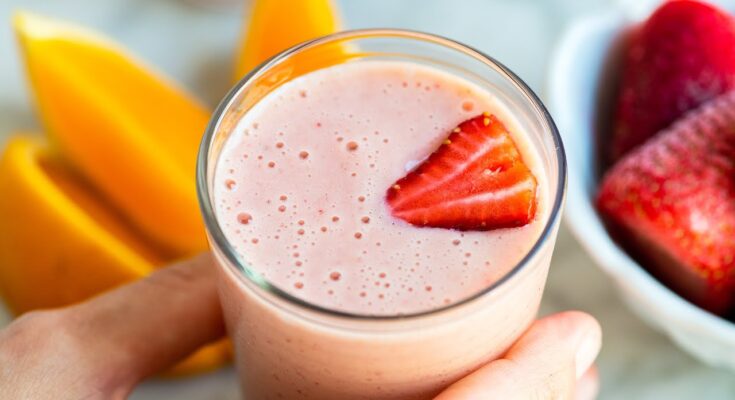Fruit Smoothie Recipe: Smoothies have become a modern-day favorite for anyone who loves quick, refreshing, and nutritious drinks. Whether you’re rushing out the door in the morning, looking for a post-workout boost, or just craving something sweet yet healthy, a fruit smoothie fits perfectly into the picture. It’s essentially nature in a glass – a vibrant blend of fruits, sometimes veggies, and often a creamy or refreshing base that makes it incredibly satisfying.
One of the reasons smoothies are so well-loved is their versatility. You can create endless variations depending on what fruits you have at home, your dietary preferences, or simply your mood. Want something tropical? Toss in pineapple and mango. Need a green detox? Spinach and kale will do the trick. Looking for indulgence? A banana and peanut butter combo never fails.
On top of that, fruit smoothies are packed with essential nutrients. They deliver vitamins, minerals, antioxidants, and fiber in every sip. They’re not just tasty; they’re also a clever way to sneak more fruits (and even vegetables) into your daily diet. Unlike sodas or processed drinks, smoothies give you natural energy, keep you hydrated, and support a healthy lifestyle.
Think of smoothies as a blank canvas—you’re the artist, and the ingredients are your colors. With a few simple steps and some fresh fruits, you can craft a masterpiece in minutes.
Why Fruit Smoothies Are So Popular
Fruit smoothies didn’t just pop up as a health trend—they became popular because they check all the right boxes: taste, nutrition, and convenience. In today’s busy world, most of us don’t have time to sit down for a big, balanced meal every morning. A smoothie solves that problem. It’s quick to make, easy to carry in a bottle, and gives you instant energy.
Smoothies are also family-friendly. Kids love them because they taste like milkshakes, while parents love them because they’re packed with vitamins. It’s a win-win situation. They’re especially helpful for picky eaters who might not want to eat fruits and veggies on their own. Blend them into a smoothie, and suddenly those foods become fun and delicious.
Another reason smoothies are everywhere is because of their adaptability to different lifestyles. Vegans can make dairy-free smoothies with almond milk or coconut water. Fitness enthusiasts often add protein powder to support muscle growth. People on weight-loss journeys can use smoothies as meal replacements with low-calorie ingredients. Simply put, smoothies are universal—you can make them fit into almost any diet.
Social media has also played a role in their rise. A colorful smoothie bowl topped with fresh fruit and seeds is not only healthy but also Instagram-worthy. This visual appeal adds to the charm and encourages more people to experiment with their own recipes.
So, whether you’re looking for health, flavor, or convenience, smoothies offer a perfect solution. They’re not just a passing trend; they’ve become a staple in many households worldwide.
Health Benefits of Smoothies
Drinking a fruit smoothie isn’t just about enjoying a tasty drink—it’s about nourishing your body. Let’s break down the health benefits you can gain from making smoothies part of your routine.
- Rich in Nutrients: Fruits are naturally packed with vitamins like vitamin C, vitamin A, and B-complex vitamins. Smoothies deliver these in a form that’s easy to consume.
- High in Fiber: Blending fruits (instead of juicing) keeps the fiber intact, which helps with digestion and keeps you full longer.
- Hydration: Smoothies often include liquids like water, coconut water, or milk, which help keep your body hydrated.
- Boosts Energy Levels: Natural sugars from fruits give you an instant energy boost without the crash you’d get from processed sugar.
- Supports Immunity: Many fruits are loaded with antioxidants that fight free radicals and strengthen the immune system.
- Weight Management: Smoothies can be tailored for weight loss or muscle gain by adjusting ingredients. Add spinach for fewer calories or oats for more fullness.
- Improves Digestion: Ingredients like yogurt, kefir, or chia seeds can improve gut health thanks to probiotics and fiber.
Think of smoothies as multitasking drinks—they refresh, energize, and heal all at once. Instead of grabbing a sugary snack or skipping a meal, a smoothie gives your body something it can truly benefit from.
Ingredients You’ll Need for a Perfect Smoothie
When it comes to smoothies, the beauty lies in their flexibility. Still, there are some must-have ingredients that form the base of almost every recipe. Once you know these basics, you can mix and match to create endless variations.
- Fruits: These are the stars of the show. Bananas, strawberries, blueberries, mangoes, pineapples, peaches, and apples are common choices. Each fruit brings its own flavor and nutrient profile.
- Liquid Base: To make blending easier and achieve the right consistency, you’ll need a liquid. Options include milk (dairy or plant-based), yogurt, fruit juice, coconut water, or simply plain water.
- Optional Add-Ins: This is where you get creative. Want more protein? Add Greek yogurt, protein powder, or nut butter. Need extra fiber? Oats, chia seeds, or flaxseeds work great. Want it sweeter? A drizzle of honey or a few dates can do the trick.
The best part is that you can adjust ingredients based on your taste and dietary needs. If you’re lactose-intolerant, plant-based milk like almond or oat milk works perfectly. If you’re aiming for a post-workout smoothie, throw in some protein powder. And if you want a dessert-like smoothie, add cocoa powder or peanut butter.
So, with just a handful of ingredients, you’re already halfway to creating a refreshing smoothie. The key is to balance flavors—sweet, tangy, and creamy—to make it both delicious and nutritious.
Essential Fruits for Smoothies
Not all fruits blend the same way. Some are naturally creamy, while others add a refreshing tang. Let’s look at some of the most popular fruits used in smoothies and why they work so well.
- Bananas: Known as the smoothie MVP, bananas add creaminess and natural sweetness. They also provide potassium, which supports heart health.
- Berries (Strawberries, Blueberries, Raspberries): Berries add a burst of flavor and are packed with antioxidants. They’re perfect for a tangy, refreshing smoothie.
- Mangoes and Pineapples: These tropical fruits bring a sunny, vacation-like flavor to your glass. They’re juicy, sweet, and rich in vitamin C.
- Peaches and Apricots: These fruits add a delicate sweetness and pair well with yogurt-based smoothies.
- Apples and Pears: Great for adding fiber and a crisp, fresh taste. They blend best when chopped finely.
- Grapes: Naturally sweet and hydrating, grapes make a good addition to green smoothies.
- Kiwi: Tangy and loaded with vitamin C, kiwi adds a zing to your blend.
When choosing fruits, freshness matters. Ripe fruits give the best flavor and blend smoothly. Frozen fruits are also excellent—they add thickness and make your smoothie colder without needing ice.
By combining different fruits, you can create layers of flavor. For example, a banana + berry combo gives creaminess and tang, while mango + pineapple creates a tropical vibe. Experimenting is half the fun of making smoothies!
Liquid Base Options (Milk, Juice, Water, Yogurt)
When making a fruit smoothie, the liquid base is just as important as the fruits themselves. Think of it as the foundation that brings all the flavors together while ensuring your smoothie blends smoothly. The choice of base also influences the texture, taste, and nutritional value of your drink. Let’s explore the most popular options and how each one affects your smoothie:
- Milk (Dairy or Plant-Based):
Milk is one of the most common smoothie bases. It creates a creamy, rich texture and blends beautifully with fruits like bananas, strawberries, and peaches. Dairy milk adds protein and calcium, making it a great option for those who want a more filling smoothie. On the other hand, plant-based alternatives such as almond milk, oat milk, or coconut milk are perfect for vegans or those with lactose intolerance. Almond milk has a mild nutty flavor, oat milk adds a slightly sweet creaminess, and coconut milk delivers a tropical twist. - Yogurt:
Yogurt is not just a base; it doubles as a nutritional powerhouse. It makes your smoothie thick and creamy while providing probiotics that support gut health. Greek yogurt, in particular, is packed with protein, making your smoothie more satisfying. If you enjoy tangy flavors, yogurt adds that extra zing, especially when paired with berries or citrus fruits. - Fruit Juice:
Fruit juice, like orange juice or apple juice, creates a sweet and tangy foundation for smoothies. It works best when you want a refreshing, light drink rather than a creamy one. However, since juice already contains natural sugars, it’s good to use it sparingly if you’re watching your sugar intake. A splash of juice can brighten the flavor of any smoothie. - Water or Coconut Water:
For a lighter, more hydrating option, water or coconut water is ideal. Plain water makes the smoothie refreshing without altering the flavor of the fruits, while coconut water adds a subtle sweetness along with electrolytes that replenish your body after workouts.
Choosing the right liquid base depends on your preference. If you want indulgence, go for milk or yogurt. If you want freshness, try juice or coconut water. The beauty of smoothies is that you can experiment—sometimes even mixing two bases for a unique twist. For example, combining yogurt and orange juice can create a deliciously creamy yet citrusy smoothie.
Optional Add-Ins (Seeds, Nuts, Sweeteners)
Here’s where smoothies become truly customizable. Once you’ve chosen your fruits and liquid base, you can add extra ingredients to boost nutrition, flavor, and texture. These optional add-ins turn a simple smoothie into a superfood-packed powerhouse.
Seeds:
- Chia Seeds: Tiny but mighty, chia seeds expand when blended, adding thickness and a boost of fiber, omega-3 fatty acids, and protein.
- Flaxseeds: Ground flaxseeds blend well and provide heart-healthy omega-3s, fiber, and lignans, which support hormone balance.
- Hemp Seeds: Soft and nutty in flavor, hemp seeds add protein, magnesium, and healthy fats.
Nuts and Nut Butters:
- Almonds, Walnuts, or Cashews: Blended nuts add creaminess, healthy fats, and protein.
- Peanut Butter or Almond Butter: These nut butters make your smoothie richer, thicker, and more filling. Perfect for post-workout drinks or when you need a meal replacement.
Sweeteners:
- Natural Sweeteners: If your smoothie needs extra sweetness, add honey, maple syrup, agave, or dates. These options are healthier than refined sugar.
- Stevia or Monk Fruit: For a calorie-free option, natural sweeteners like stevia can help keep your smoothie sweet without adding sugar.
Other Superfoods:
- Oats: Rolled oats add fiber and make your smoothie heartier.
- Cacao Powder: For a chocolatey flavor that’s antioxidant-rich.
- Protein Powder: A favorite for athletes or those on high-protein diets.
- Spices: Cinnamon, ginger, or turmeric not only enhance flavor but also bring unique health benefits.
Adding these extras lets you tailor your smoothie to your needs. Want a morning energy boost? Add chia seeds and oats. Need muscle recovery? Go for protein powder and peanut butter. Craving dessert vibes? Mix in cacao powder and banana. The possibilities are endless.
Choosing the Right Equipment
A great smoothie starts with good ingredients—but the equipment you use makes all the difference. While it’s possible to make a smoothie with just a basic blender, having the right tools ensures a smoother texture, quicker prep, and less mess in the kitchen.
Best Blenders for Smoothies
Not all blenders are created equal. A high-powered blender can crush ice, frozen fruit, and nuts with ease, while a weaker one might leave chunks behind. Here are some options:
- High-Speed Blenders (Vitamix, Blendtec, Ninja): These are the gold standard for smoothie lovers. They can blend anything to a silky consistency, from tough kale leaves to frozen mango chunks. While they’re more expensive, they’re worth it if you make smoothies often.
- Personal Blenders (NutriBullet, Magic Bullet): Compact, affordable, and perfect for single servings. They’re easy to use and clean, making them a great option for busy mornings.
- Standard Kitchen Blenders: Good for beginners, though they might struggle with hard or frozen ingredients. Still, they work fine if you’re using softer fruits like bananas and peaches.
Handy Tools to Make Smoothie Prep Easier
Besides a blender, a few extra kitchen tools can make your smoothie experience smoother:
- Measuring Cups and Spoons: Helpful for keeping portions consistent, especially if you’re counting calories or nutrients.
- Mason Jars or Smoothie Bottles: Ideal for storing or carrying your smoothie on the go.
- Reusable Straws: A sustainable way to enjoy your drink without spills.
- Freezer Bags: Great for prepping smoothie packs ahead of time—just toss fruit into bags and freeze, then blend when needed.
Choosing the right equipment ensures your smoothie routine is quick, easy, and enjoyable. The goal is to make the process so simple that you’ll want to make smoothies every day without hassle.
Step-by-Step Guide to Making a Fruit Smoothie
Now that you know the ingredients and equipment, let’s get into the actual process of making the perfect smoothie. Making a smoothie may sound simple—just blend and drink—but there’s an art to layering the ingredients correctly and achieving the right balance of flavors.
Step 1 – Gather and Prepare Your Ingredients
Preparation is key. Wash your fruits thoroughly, peel bananas, remove stems from berries, and cut larger fruits like mangoes or pineapples into small chunks. If you want a colder, thicker smoothie, consider freezing your fruits beforehand.
Place all your chosen ingredients on the counter—fruits, liquid base, and optional add-ins. Having everything ready makes the blending process smoother (pun intended).
Step 2 – Add the Liquid Base First
Always start by pouring your liquid base into the blender. This prevents the blades from jamming and ensures all ingredients blend evenly. Aim for about 1 to 1.5 cups of liquid, depending on how thick you want your smoothie.
Step 3 – Add Fruits and Other Ingredients
Next, add your fruits, starting with the softer ones like bananas or peaches, then layering harder or frozen fruits on top. After that, toss in any extras like chia seeds, protein powder, or nut butter.
Step 4 – Blend Until Smooth
Secure the lid and blend on high speed for 30–60 seconds, or until the mixture is creamy and lump-free. If your smoothie is too thick, add a splash of liquid and blend again. If it’s too thin, toss in a few ice cubes or more frozen fruit.
Step 5 – Taste, Adjust, and Serve
Before pouring your smoothie into a glass, taste it. Need more sweetness? Add honey. Too tangy? Add a banana. Too thick? More liquid. Once you’re satisfied, pour it into a glass or smoothie bottle and enjoy immediately.
Variations of Fruit Smoothie Recipes
The beauty of smoothies lies in their versatility. Once you’ve mastered the basic method, you can create endless variations depending on your taste preferences, health goals, or even the season. Here are some delicious smoothie recipes you can try:
Tropical Fruit Smoothie
If you’re craving vacation vibes, a tropical smoothie is the way to go. Imagine sipping sunshine in a glass with the sweet tang of pineapple, mango, and banana.
Ingredients:
- 1 cup frozen mango chunks
- 1 cup pineapple pieces
- 1 banana
- 1 cup coconut milk or coconut water
- 1 tablespoon chia seeds (optional)
Why it works: Mango and pineapple bring bright, juicy sweetness, while coconut adds creaminess and tropical flair. This smoothie is refreshing, hydrating, and full of vitamin C.
Berry Blast Smoothie
Berries are antioxidant powerhouses, making this smoothie both tasty and nourishing. Perfect for a quick breakfast or post-workout snack.
Ingredients:
- 1 cup strawberries
- ½ cup blueberries
- ½ cup raspberries
- 1 banana (for creaminess)
- 1 cup almond milk or Greek yogurt
- 1 teaspoon honey or maple syrup (optional)
Why it works: Berries deliver tartness, banana adds smoothness, and almond milk makes it light yet filling. It’s like drinking a berry dessert—without the guilt.
Green Smoothie with Spinach and Kale
For those who want a nutrient-packed detox, this green smoothie is a game-changer. Don’t worry—the fruits balance out the earthy greens.
Ingredients:
- 1 cup spinach leaves
- ½ cup kale (stems removed)
- 1 apple (chopped)
- 1 banana
- 1 cup coconut water or orange juice
- 1 tablespoon flaxseeds
Why it works: Spinach and kale bring iron, vitamins, and antioxidants. The apple and banana sweeten things naturally, while flaxseeds add fiber and healthy fats. This smoothie is a powerhouse for energy and digestion.
Protein-Packed Smoothie
If you’re hitting the gym or need a meal replacement, this smoothie delivers a protein boost while still tasting delicious.
Ingredients:
- 1 banana
- 1 cup almond milk
- 2 tablespoons peanut butter
- 1 scoop vanilla protein powder
- 1 tablespoon oats
- A few ice cubes
Why it works: Protein powder and peanut butter keep you full and support muscle recovery. Oats add extra fiber, making this smoothie more satisfying than a snack—it’s practically a meal in itself.
Tips and Tricks for the Best Smoothies
Even though making smoothies is simple, a few tricks can help you take them from “good” to “amazing.” Whether it’s about consistency, flavor balance, or storage, these tips will ensure your smoothies turn out perfect every time.
How to Make Your Smoothie Creamier
- Use frozen bananas as a natural thickener.
- Add a spoonful of Greek yogurt for creaminess and protein.
- Try avocado—it blends smoothly without overpowering the flavor.
- Use oat milk or coconut milk instead of water for a rich texture.
How to Store Smoothies for Later
Smoothies taste best fresh, but you can store them for convenience:
- Keep them in an airtight glass jar or bottle.
- Store in the fridge for up to 24 hours. Shake well before drinking.
- For longer storage, freeze smoothie packs with pre-cut fruit. When ready, just add liquid and blend.
Common Mistakes to Avoid
- Adding too much liquid: This can make your smoothie watery. Always start small and add more if needed.
- Skipping protein or fiber: Without them, your smoothie won’t keep you full. Add seeds, oats, or yogurt.
- Overloading on sweeteners: Fruits are naturally sweet—too much honey, juice, or syrup can spike sugar levels.
- Not blending long enough: Stop too soon, and you’ll end up with chunks. Blend until silky smooth.
Mastering these tricks ensures your smoothies are consistently tasty, nutritious, and satisfying.
Nutritional Benefits of Fruit Smoothies
Smoothies aren’t just about taste—they’re nutrient-packed beverages that can transform your health when enjoyed regularly. Each ingredient you add has unique benefits, so let’s break them down:
Vitamins and Minerals in Fruits
- Bananas: High in potassium, good for heart and muscle health.
- Berries: Rich in antioxidants, protecting your cells from damage.
- Citrus Fruits (Oranges, Pineapples): Loaded with vitamin C to boost immunity.
- Mangoes: Provide vitamin A, which supports vision and skin health.
Smoothies for Weight Loss
Smoothies can be tailored for weight loss if you focus on low-calorie, high-fiber ingredients:
- Use greens like spinach or kale for nutrients with minimal calories.
- Add chia seeds or flaxseeds for fullness.
- Replace juice with water or unsweetened almond milk to cut sugar.
- Avoid adding too much nut butter or sweeteners.
A green smoothie with spinach, cucumber, and apple is a perfect example of a light, detox-friendly option.
Smoothies for Energy Boost
Need a morning pick-me-up? Certain smoothies are designed to energize:
- Bananas + Oats: Provide slow-releasing energy.
- Berries: Natural sugars for instant energy.
- Peanut Butter + Protein Powder: Keeps you powered for hours.
Instead of reaching for coffee, try a smoothie with banana, oats, and almond butter—you’ll feel energized without the caffeine jitters.
FAQs about Fruit Smoothie Recipe
1. Can I make a smoothie without a blender?
Yes! While a blender is best, you can mash soft fruits like bananas and berries with a fork, then mix with yogurt or milk. It won’t be as smooth, but it still works.
2. Are smoothies good for kids?
Absolutely. They’re a great way to sneak in fruits and veggies. Just avoid adding too much sugar or caffeine-based ingredients.
3. Can I replace a meal with a smoothie?
Yes, if you add enough protein, fiber, and healthy fats. For example, a smoothie with oats, yogurt, peanut butter, and fruit can keep you full for hours.
4. Should I use fresh or frozen fruits?
Both work. Fresh fruits give a lighter taste, while frozen fruits make smoothies thicker and colder without ice.
5. Can smoothies help with digestion?
Yes, especially if you include fiber-rich ingredients like oats, flaxseeds, or leafy greens. Yogurt-based smoothies also support gut health with probiotics.
Conclusion
By understanding the basics—choosing the right fruits, liquid base, and optional add-ins—you can craft smoothies that are not only satisfying but also nourishing. Remember to experiment, try different combinations, and make it fun. After all, the best smoothie is the one you enjoy the most.
So, the next time you’re hungry, thirsty, or simply in need of a little energy, skip the sugary drinks and fast food. Blend up a smoothie instead—you’ll be doing your body (and taste buds) a big favor.



